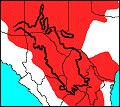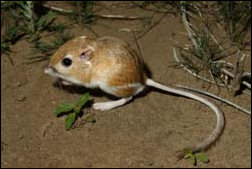


Dipodomys ordii. This is a photograph from the Wikimedia Commons, released into the public domain by its author, the Royal Alberta Museum.
A wealth of information on this animal is available from the New Mexico Department of Game and Fish through their information system, BISON.
Dipodomys is active throughout the year and is mainly nocturnal in behavior (Burt, 1980). Their hind legs are long and powerful, making them highly modified for travel by jumping. They use their tail to balance and to prop themselves up when standing. It is because of their saltorial (jumping) habits that they are named and compared to the kangaroo. They build burrows and tunnels under trees and bushes that contain chambers for storing food, and they remain here for extended periods when the weather is unfavorable. They derive all the water they need from the seeds and plant material that they eat (Walker, 1983).
Burt, W.H. 1980 A Field Guide to the Mammals - North America north of Mexico. Houghton Mifflin Company, New York, 148 pp.
Walker, E.P. 1983. Mammals of the World (4th Edition). The John Hopkins University Press, Baltimore.
Heather Jasso, March 2000.
Last Update: 19 Jul 2009